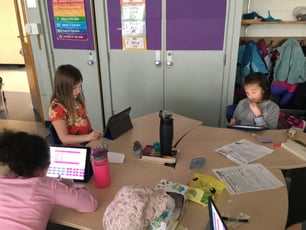This is Mrs. Schoff's first year as PLTW Launch Lead Teacher for Memorial and Parkview Elementary Schools in Valparaiso, Indiana. After teaching for 13 years in the general education classroom, she was excited to accept the position of STEM teacher for K-5 students. So far the switch has been a refreshing return to the way teaching should be. She is looking forward to continuing this fun journey of exploration and learning with her students.
The first day of Grids and Games was filled with questions. “What is computer coding?” “Why doesn't the computer speak the same language that we do?” “How will I tell my character what to do if it can't understand me?” And my personal favorite: “What do you mean Rosie just walked off the grid? I TOLD her to turn right!”
I enjoyed being Rosie and hamming it up as I walked off the grid and banged into the wall. I even pouted a bit when I landed on a bone card but they forgot to tell me to pick it up. The students really got a kick out of watching the glitches play out in real life. Some groups even began adding glitches to see me do silly things.
The first challenge my students had to overcome was working cooperatively to tell Rosie how to maneuver the grid. There were some tense moments that erupted over the use of a “move forward” card versus a “turn right” card! Ultimately I was able to capitalize on some teachable moments about teamwork, communication, and cooperation. I hope that the lessons they learned carried over into the classroom group work situations.
After figuring out how to nicely communicate with each other; getting the hang of telling a character how to move; and watching the introduction to Scratch Jr, my kids quickly found success with the next activity: Moving with Math. I watched students furrow their brows while reading carefully, asking each other questions, and literally scratching their heads as they worked through the steps.
They finally anxiously tested out each challenge. When it worked, they were delighted. When something was wrong, they showed amazing perseverance in returning to the programming and instructions to figure out the glitch. I overheard some incredible conversations as they worked through each challenge and guided peers past obstacles. It seems that there is at least one moment in every class session when students surprise me with their ability to overcome the problems and extend the activity in creative ways. My early finishing students, for example, would use their new skills and apply them in out-of-the-box ways. For example, one student created a scene in which you answer the question, “Do you like cats or dogs? Tap one.” When the player taps on a character, the animal dances around and says “Thank you!” while the other character disappears. That is intricate programming with taps, messages, move blocks, and audio!
It did take some adjustment time for me as I got used to saying, "I don't know. What do you think you will need to do to fix that?" After years in a classroom where I was the hand pulling students through the material instead of the gentle push in the correct direction, being so hands-off was a challenge for me at first. But just like my kids as they tackle the coding activities in the PLTW curriculum, I have embraced it and happily say, "Challenge accepted!" We are learning together as we go and growing together as we learn.
PLTW’s blog is intended to serve as a forum for ideas and perspectives from across our network. The opinions expressed are those of each guest author.


